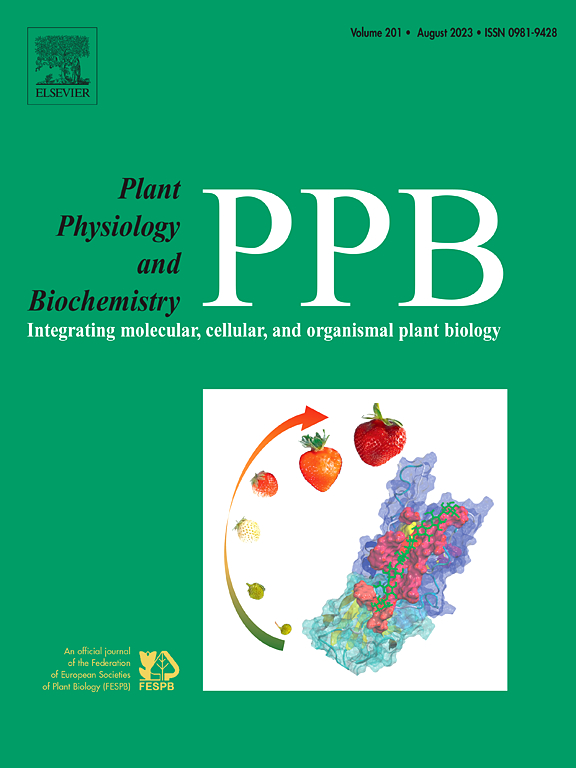在盐胁迫下,硫化氢通过调节光能耗散和类囊体蛋白的可逆磷酸化来提高水稻光合效率
IF 6.1
2区 生物学
Q1 PLANT SCIENCES
引用次数: 0
摘要
硫化氢(H2S)被认为是一种与植物对环境胁迫的生理生化调节有关的小气体递质。然而,在逆境条件下,植物中H2S对光合作用的调控机制尚不清楚。本文研究了H2S在盐胁迫下水稻幼苗光系统I (PSI)和光系统II (PSII)调控中的作用。结果表明,NaHS (H2S供体)处理显著提高了PSI和PSII的光合色素含量、气体交换参数和光化学能力,而NaHS与H2S清除剂次乙磺酸(HT)或抑制剂羟胺(HA)一起施用导致盐胁迫下水稻的光合效率下降。nahs预处理的植株在盐胁迫下表现出快速的能量耗散和较高的电子传递速率(ETR),而HA和HT处理进一步抑制了这些过程。此外,我们发现H2S对盐胁迫的保护机制与几种PSII蛋白水平的升高、类囊体蛋白的快速可逆磷酸化以及PSII- lhcii超配合物和PSI-PSII二聚体的稳定有关。综上所述,我们的研究结果表明H2S可以通过优化水稻的电子传递效率和协调调节PSII蛋白磷酸化来促进光合机制的耐盐性。本文章由计算机程序翻译,如有差异,请以英文原文为准。
Hydrogen sulfide improves photosynthetic efficiency by regulating light energy dissipation and reversible phosphorylation of thylakoid proteins in rice under salt stress
Hydrogen sulfide (H2S) has been regarded as a small gasotransmitter associated with physiological and biochemical regulation in plant responses to environmental stresses. However, the regulatory mechanisms of H2S in photosynthesis under adverse conditions remains poorly understood in plants. Here, the role of H2S in the regulation of photosystem I (PSI) and photosystem II (PSII) was investigated in rice seedlings subjected to salt stress. Our results showed that NaHS (H2S donor) pretreatment significantly enhanced photosynthetic pigment content, gas exchange parameters, and the photochemical capacity of both PSI and PSII, while the application of H2S scavenger hypotaurine (HT) or inhibitor hydroxylamine (HA) with NaHS resulted in the decline in photosynthetic efficiency in rice under salt stress. NaHS-pretreated plants displayed the rapid energy dissipation and an elevated electron transport rate (ETR), whereas HA and HT treatments further suppressed these processes under salt stress. Furthermore, we found that the protective mechanism of H2S against salt stress was associated with the elevated levels of several PSII proteins, rapidly reversible phosphorylation of thylakoid proteins, and the stabilization of PSII-LHCII supercomplexes and PSI-PSII dimers. Collectively, our results demonstrate that H2S can contribute to salt tolerance of photosynthetic machinery by optimizing electron transport efficiency and the coordinated regulation of PSII protein phosphorylation in rice.
求助全文
通过发布文献求助,成功后即可免费获取论文全文。
去求助
来源期刊
CiteScore
11.10
自引率
3.10%
发文量
410
审稿时长
33 days
期刊介绍:
Plant Physiology and Biochemistry publishes original theoretical, experimental and technical contributions in the various fields of plant physiology (biochemistry, physiology, structure, genetics, plant-microbe interactions, etc.) at diverse levels of integration (molecular, subcellular, cellular, organ, whole plant, environmental). Opinions expressed in the journal are the sole responsibility of the authors and publication does not imply the editors'' agreement.
Manuscripts describing molecular-genetic and/or gene expression data that are not integrated with biochemical analysis and/or actual measurements of plant physiological processes are not suitable for PPB. Also "Omics" studies (transcriptomics, proteomics, metabolomics, etc.) reporting descriptive analysis without an element of functional validation assays, will not be considered. Similarly, applied agronomic or phytochemical studies that generate no new, fundamental insights in plant physiological and/or biochemical processes are not suitable for publication in PPB.
Plant Physiology and Biochemistry publishes several types of articles: Reviews, Papers and Short Papers. Articles for Reviews are either invited by the editor or proposed by the authors for the editor''s prior agreement. Reviews should not exceed 40 typewritten pages and Short Papers no more than approximately 8 typewritten pages. The fundamental character of Plant Physiology and Biochemistry remains that of a journal for original results.

 求助内容:
求助内容: 应助结果提醒方式:
应助结果提醒方式:


